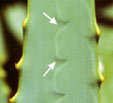In nature every Purim day
Alex Doron

We've all heard of animals using camouflage colors to protect themselves from predators. Chameleons, frogs, spiders, butterflies, fish and even bedbugs - all wear colorful masks as defense or attack mechanisms. Certain plants also make use of spectacular costumes for reproduction. Take for example the bumblebee, a flower from the orchid family, which "disguises itself" as a bee. When the male bee lands on her in anticipation of mating, the beekeeper "dirts" him with pollen, which is then transferred to another flower with its help.
on elephants and ants
Now Israeli researchers have discovered plants that disguise themselves as animals as a defense against their enemies - a sophisticated strategy that was not fully understood until today. The biologist Prof. Simcha Labidon and the entomologist (insect researcher) Dr. Moshe Inbar, from the Faculty of Sciences and their teaching at the University of Haifa, discovered three methods of "disguising" and impersonating insects, which plants use as a defense mechanism. On the pod of the wild pea that was discovered in the Golan and on the large topah and the bikia that are found, red-brown dots appear, a kind of costume for the larvae of a poisonous butterfly. True caterpillars mark themselves like this, as a warning to their environment that they are dangerous and poisonous.
In the two-row pasphalon, reproductive cells were discovered that are covered with points that resemble aphids in motion. Dark and elongated spots appear on the stem and petioles of the leaves - a kind of "disguise" for the ants - also on the loofah (also known as "Aaron's staff") and near the streams. Prof. Lev-Yadon explains: "Plant-eating animals do not touch stained fruits, fearing that the lesions are related to poisonous mushrooms and poisonous bacteria. Careless tasting can result in illness and death. The ants are hated by many animals, even large ones, due to their aggression and bites. For example, when ants attack an elephant and penetrate his eyes - he may go blind and die.''
The passion fruit scam
The three discoveries add to what is known about the passion fruit. The fruit is equipped with an organ that looks like butterfly eggs, and its purpose is to prevent the butterflies from laying eggs in it. Butterflies avoid laying eggs where eggs have already been laid, so that competition for food does not develop between the larvae, which ends in death by starvation.
Prof. Lev-Yadon: "In nature there are also 'cheaters' who imitate cacti for warning, like the agaves. Their spines are sharp and curved, but on the surface of the fleshy leaves you can see prints of spines, which are not spines at all. The agave has 200 thorns, along with the prints, but you get the impression that there are twice as many.
According to a very cautious estimate, at least 4,000 plant species in the world use different disguises for protection purposes. Israel also has such plants - out of the 2,700 species of plants in the country (about half a percent of all plant species in the world), only ten "in disguise" are known today, but their number may be twice that.
Together with Prof. Ido Itzhaki, also from the University of Haifa, Prof. Lev-Yadon is completing a new study in which for the first time animals will be described that avoid eating the plants protected by their unique coloring. Until today, this was only speculation.
